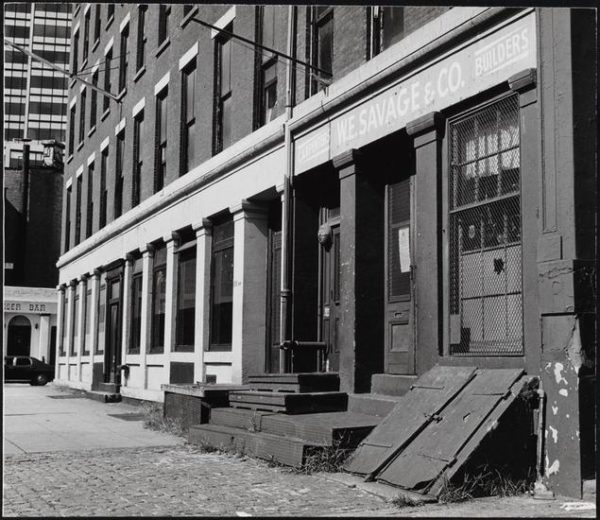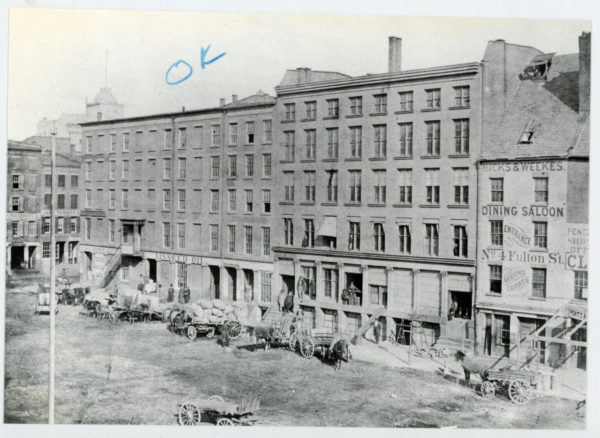The South Street Seaport provides a pivotal connection to New York City’s early days as a center of maritime industry. Indeed, the city’s settlement and growth were inextricably linked to its success, and this history remains embodied in the area’s low-scale, early 19th century commercial buildings, as well as its historic piers and streets, complete with historic Belgian blocks.
The area around Peck Slip was for centuries a Native American gathering and trading destination; its proximity to Long Island and the presence of a cove made this a natural landing point for canoes, linking footpaths on either side of the East River, which is narrower and more navigable than the Hudson River. Settlers of New Amsterdam took advantage of this favorable geography by establishing the colony’s first official ferry service in 1642, linking Brooklyn to what became Peck Slip, an active dock until the early 19th century. Lower Manhattan’s marshy eastern shoreline was once peppered with inlets that became docks and wharves for the shipping industry. The ferry service to the Peck Slip area allowed for the transportation of agricultural goods from Long Island, spurring the creation of one of the city’s first farmers’ markets. In 1647, the Englishman Isaac Allerton constructed a warehouse at this natural cove, apparently to store tobacco from Virginia to be shipped to Europe. The banks of the cove were filled in and extended to ease loading and unloading from the ships’ sides. This marked the beginning of the landfilling process, which extended along the East River shoreline from Pearl Street to South Street, forming the foundation of the low-rise “Seaport” district. The locations of the slips are discernible today as extra wide streets right at the edge of Manhattan, like Peck Slip.
Despite lagging behind Boston, Philadelphia and Charleston for much of the 18th century, by 1797, South Street Seaport was the nation’s leading port. Several factors contributed to its success, including the opening of a trade route between New York and Guangzhou, when the Empress of China embarked on its maiden voyage in 1784. Soon after the Revolutionary War, the British re-established trade with the United States, and determined New York to be the most ideal export location. These international voyages aided the city tremendously in becoming a global force in maritime commerce. The 1825 completion of the Erie Canal opened shipping routes between the Atlantic Ocean and the Great Lakes, further cementing the city’s importance as a maritime trading center. The South Street Seaport’s earlier residential buildings were converted to commercial use and new ones were built catering to maritime trade businesses. Many structures from this era still exist, providing the visitor with a clear reading of the area’s past as an early 19th century maritime neighborhood. Its range of buildings was largely designed in simplified forms of the Georgian, Federal, Greek Revival, Italianate and Romanesque Revival styles. Only a minority of early stores and warehouses were the work of professional architects, but by the late 19th century, several well-known architects, including Stephen D. Hatch, Richard Morris Hunt and George B. Post, had designed commercial buildings here.
The second half of the 20th century brought much change to the Seaport, with efforts at urban renewal and its transformation into a tourist-friendly “festival marketplace”. In 1972, the National Register of Historic Places accepted the nomination of the South Street Seaport Historic District, which was expanded in 1977. That same year, the New York City Landmarks Preservation Commission (LPC) designated the South Street Seaport Historic District, and in 1989 designated the South Street Seaport Historic District Extension. The buildings in these historic districts date from a period of roughly 200 years, from the late 18th to the 20thcenturies, and serve to tell a rich and complex story to today’s visitors.
South Street Seaport was a Six to Celebrate neighborhood
Location
Located in lower Manhattan along the East River waterfront,
159-163 John Street Building
159-163 John Street, NY, USASTATUS: Designated Individual Landmark
South Street Seaport Historic District and Extension
South Street Seaport, Front Street, New York, NY, USASTATUS: Designated Historic District
All Buildings in South Street Seaport
alphabetical
- 165 John Street Building
- 167-171 John Street Building
- 170-176 John Street Building
- 189 Front Street Building
- 191 Front Street Building
- 193 Front Street Building
- 195 Front Street Building
- 91 South Street Building (Schermerhorn Row Block)
- 92 South Street Building (Schermerhorn Row Block)
- South Street Seaport Historic District and Extension
- Whitehall Ferry Terminal



